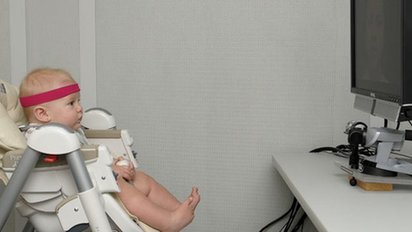最新研究表明,嬰兒不僅僅通過聲音來學(xué)習(xí)語言,“讀唇”也是一種重要的學(xué)習(xí)方式。這一研究成果有助于自閉癥的診療。之前學(xué)界普遍認(rèn)為,嬰兒僅通過聲音來學(xué)習(xí)語言,而科學(xué)家們在對21個成年人和89名年齡在4個月至12個月之間的嬰兒進(jìn)行研究后得出了上述結(jié)論。實驗中,所有參與者都戴上一個眼部追蹤器來觀看一段長50秒的視頻,其中有一位女士用參與者的母語(英語)朗誦一段獨白。眼部追蹤器記錄下參與者在看(聽)視頻時瞳孔的運動軌跡。研究人員發(fā)現(xiàn),4個月大的嬰兒和成年人一樣,看視頻時更多時間是關(guān)注講話者的眼睛,但6個月到12月的嬰兒則既看眼睛也看嘴。從看嘴到看眼的轉(zhuǎn)變過程究竟在什么年齡段徹底完成,研究者目前尚無法確定。
一位研究人員說:“12個月大的寶寶已經(jīng)初步掌握字詞、語言結(jié)構(gòu),也能辨別聲音了,他們已經(jīng)初步形成了自己的言語體系,可以只看講話者的眼睛,因為眼睛能傳達(dá)大量的社交信息……眼睛是大腦的窗口,看他人的眼睛,我們就能知道他在想什么,他想要什么,他有何欲望。”這一研究結(jié)果將有助于自閉癥的早期診斷。

|
 |
|
Infants May Use Lip Reading to Learn Language |
Infants learn language not only through sound, but also through lip reading, according to a new study published in the journal Proceedings of the National Academy of Sciences.
Researchers say the new findings defy the conventional view that babies learn to speak through sound alone and the research may even assist in diagnosing autism spectrum disorders in the future.
Scientists from Florida Atlantic University studied 89 infants ranging in age from 4 months to 12 months old. They also studied 21 adults. Participants watched a 50-second video of a woman reciting a monologue in their native English, while researchers used an eye tracker to determine where they directed their pupils while watching and listening to the video.
Four-month-old infants, along with adults, spent more time looking at the speaker's eyes. But babies between 6 and 12 months shifted their attention between the speaker's mouth and eyes. It is unknown at what age the shift from mouth to eyes is totally complete, but the older infants tended to look at the speaker's eyes more than her mouth.
"By this time at 12 months, babies are already producing their first words and have mastered the first sounds and structures of the language," said David Lewkowicz, an expert on infant perceptual development and lead author of the study. "They no longer have to lip-read as they ramp up their first speech patterns and they are free to shift back to the eyes, where you find a great deal of social information.
"The eyes are the window to the brain, and by looking at the eyes, we are able to know what the other person is thinking and what they want, their desires," he said.
"This research confirms and extends what we already know about typical development: Language is not just an auditory process, it is the integration of visual and auditory information as the child learns words," said Stephen Camarata, professor of hearing and speech sciences at Vanderbilt University. "What happens in infancy has important ramifications for later development."
Researchers said the data could contribute to autism research, as well. Two-year-old children with autism attend more to speaker's mouths, according to past literature on the developmental disorder. This study shows that attention to the mouth is a normal developmental phase during the first year, and the comparision could aid in autism diagnosis at an earlier age.
"Right now, the earliest one can diagnose a child with autism is 18 months, so this could possibly be a way in the future to diagnose infants as early as 12, 13 or 14 months if we find babies are not making a shift back to the eyes around this age," Lewkowicz said. "If that is the case, this would be a huge step forward in the development of diagnostic tools for autism because it would be six months earlier than what we can do now.
"Because the brain is so elastic and there is an enormous proliferation of neuro structure during infancy, if we could pick up these difficulties as early as 12 months, we could begin to intervene at an earlier time and get far better outcomes in children," he said.
But Rhea Paul, director of the Yale Child Study Center's Laboratory of Development Communication Disorders, warned that an autism diagnosis is not so easily simplified, and it could be dangerous to make blanket claims regarding autism and eye attention.
"I think caution is always warranted when attempting to identify a single early 'marker' for a developmental disorder, such as failure to go back to looking at eyes at 12 months as a sign of autism, simply because of the great variability in behavior and development that is normal in the first couple of years of life," Paul told ABCNews.com.
Thirty percent of children that researchers attempted to test had to be eliminated for a variety of reasons.
"It could be that the children they could not test would have, if they could have been tested, provided a different set of results," Paul said. "The point is that we would need lots of replication and extension of studies of infant behavior before we could responsibly apply single behavioral measures as diagnostic standards. We should not be too quick to draw conclusions about a difference between a 'normal' group of infants -- from which will usually be excluded lots of fussy, wiggly, uncooperative but otherwise normal babies -- and a group with a single disorder."
A better way to identify diagnostic markers for a particular condition, such as autism, would be to compare infants at risk for autism, such as infant siblings of children already diagnosed with autism, with those at low risk for any disability and with those at high risk, due to family history, or other developmental disorders, Paul said.
"If, for example, infants at risk for autism spectrum disorders [or ASD] show differences in gaze patterns that are similar to those seen in infants with risk for language disorder, it may be that the gaze pattern is more closely related to the language problems that so often accompany ASD than to autism itself," she said.
Perhaps the most important real-world aspect of the study is the importance of visual processing (in addition to auditory processing) in infancy, Camarata said.
"Smiling and talking to the baby are not idle exercises, rather these are the foundation of how babies and children earn to communicate," Camarata said. "Parents should keep their face relatively close to the baby, smile a lot and talk a lot. Keep the engagement going, this is an important part of how a child learns to talk."
相關(guān)閱讀
(Agencies)

(英語點津?Rosy 編輯)
